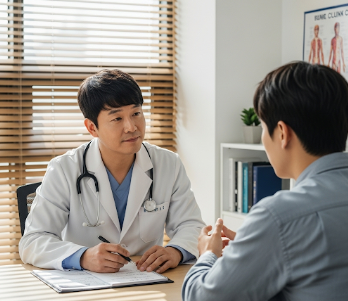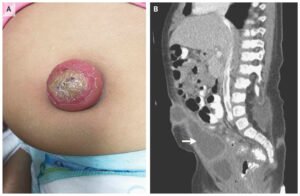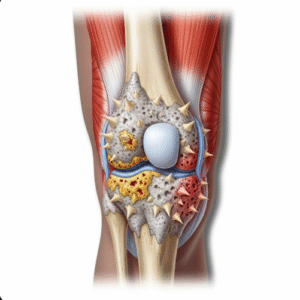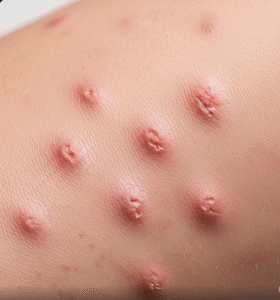Overview
Yellow semen refers to a discoloration of ejaculate from its usual whitish-gray appearance to a yellowish hue. While it is often harmless and temporary, it can sometimes indicate underlying medical conditions affecting the reproductive or urinary systems.
➤ Color changes in semen may result from diet, infections, medications, or prolonged abstinence.
➤ In Korea, urology and andrology clinics provide evaluation and treatment for men concerned about semen color changes.
➤ Understanding the cause is important for fertility, reproductive health, and early detection of infections.
Key Facts
► Definition: A change in semen color to yellow, which may be light, dark, or greenish-yellow.
► Prevalence: Common among men; usually benign but can indicate infection or prostate issues.
► Symptoms: May include discomfort, urinary changes, foul odor, pain, or fever if associated with infection.
► Risk factors: Poor hydration, prolonged abstinence, infections (bacterial or viral), prostate inflammation, or certain medications.
► Treatment in Korea: Focuses on diagnosis, treating underlying infection, lifestyle modification, and reproductive health counseling.
What Is Yellow Semen?
Yellow semen occurs when the ejaculate acquires a yellow tint, often due to minor changes in composition or underlying pathology.
➔ Semen contains sperm, seminal fluid, and secretions from the prostate and seminal vesicles.
➔ Yellow coloration may result from concentrated urine remnants, infection, or dietary factors.
➔ It can be temporary or persistent, and evaluation is recommended if the discoloration lasts more than a few weeks or is associated with other symptoms.
What Symptoms Are Related to Yellow Semen?
Symptoms vary depending on the underlying cause:
→ Changes in semen color: light yellow, dark yellow, or greenish-yellow.
→ Foul-smelling semen, which may suggest infection.
→ Pain or burning during urination (dysuria).
→ Testicular or pelvic pain.
→ Swelling of the prostate or epididymis.
→ Fever or malaise in severe infections.
→ Changes in sexual or urinary function in chronic conditions.
Causes / Possible Causes of Yellow Semen
Benign Causes
➤ Prolonged abstinence: Semen can accumulate and become concentrated, turning yellow.
➤ Diet and supplements: Foods like garlic, onion, or certain vitamins can cause yellowing.
➤ Aging: Semen naturally changes color and consistency with age.
Infectious Causes
➔ Sexually transmitted infections (STIs) – Chlamydia, gonorrhea, trichomoniasis can cause yellow or green semen.
➔ Urinary tract infections (UTIs) – Bacterial infections in the urinary tract or prostate may discolor semen.
➔ Prostatitis (inflammation of the prostate) – Chronic or acute prostatitis often causes yellow, foul-smelling semen.
Other Medical Causes
→ Jaundice or liver disease – Bilirubin buildup may alter semen color.
→ Retrograde ejaculation – Urine mixing with semen can cause yellow hue.
→ Medications – Antibiotics, supplements, or medications affecting metabolism may influence semen color.
When Should I See My Doctor?
Medical evaluation is recommended if:
➤ Yellow semen persists for more than 2–3 weeks.
➤ Pain, burning, or swelling occurs in the genital or pelvic area.
➤ Foul odor or abnormal consistency accompanies discoloration.
➤ Fever, fatigue, or urinary changes are present.
➤ There is concern about fertility or sexual health.
Early evaluation helps detect infections, prostate issues, or metabolic disorders, preventing complications and improving reproductive health.
Care and Treatment
Lifestyle and Self-Care Measures
► Stay well-hydrated to prevent concentrated semen.
► Practice good genital hygiene to reduce infection risk.
► Maintain regular ejaculation patterns to avoid semen accumulation.
► Avoid excessive alcohol, tobacco, or drugs that affect semen quality.
► Eat a balanced diet rich in antioxidants, vitamins, and minerals to support reproductive health.
Medical Treatments
➔ Antibiotics or antivirals for bacterial or viral infections.
➔ Anti-inflammatory medications for prostatitis or pelvic inflammation.
➔ Medication review if supplements or drugs are causing discoloration.
➔ Urinary evaluation to rule out UTIs or other urogenital problems.
Procedural and Advanced Interventions
→ Prostate evaluation via digital rectal exam or ultrasound if chronic prostatitis or other prostate conditions are suspected.
→ Semen analysis for fertility evaluation and detection of abnormal parameters.
→ Urine culture and STI testing to detect bacterial or viral infections.
→ Referral to urologist or andrologist for persistent or recurrent cases.
Treatment Options in Korea
Diagnosis and Assessment
➤ Urology clinics in Korea provide semen analysis, urine tests, and STI screening.
➤ Imaging studies like transrectal ultrasound may be used to evaluate the prostate and seminal vesicles.
➤ Blood tests can assess liver function or systemic infections affecting semen color.
Non-Surgical Care
► Antibiotics and anti-inflammatory medications for infections or prostatitis.
► Lifestyle guidance including hydration, diet, and hygiene.
► Counseling for sexual health and fertility concerns.
Advanced Care
➔ Minimally invasive procedures for chronic prostatitis or obstruction if conservative care fails.
➔ Specialist referral for fertility assessment or urologic surgery if structural issues are detected.
➔ Long-term monitoring for chronic infections or recurrent symptoms.
Rehabilitation and Lifestyle Support
→ Education on safe sexual practices and STI prevention.
→ Nutritional and lifestyle counseling to improve semen quality and reproductive health.
→ Regular follow-up to monitor semen color, infection resolution, and overall urogenital health.
Korean hospitals and clinics provide comprehensive evaluation, medical treatment, and preventive care for yellow semen, ensuring optimal reproductive health, early infection detection, and long-term wellbeing.













